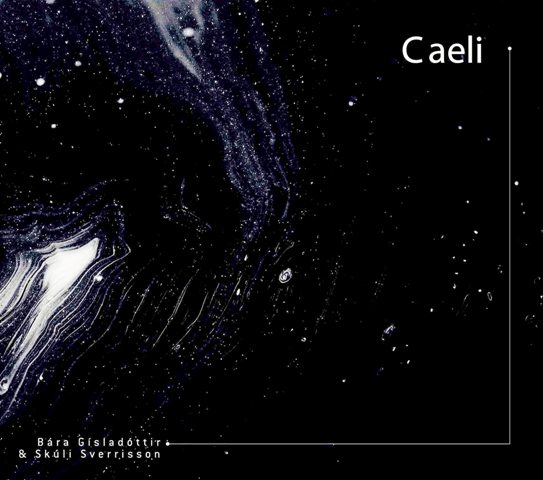
GÍSLADÓTTIR-SVERISSON: Caeli / Bára Gísladóttir, bs; Skúli Sverisson, gtr / Sono Luminus SLE-70020
This strange little album explores the “skies and dimensions merging into a borderless being boasting of a rich and vivid textures, at times carrying numerous worlds inside at once. During the recording of Caeli, Bára and Skúli would have long discussions about how the world is opening up and how this would and could affect music as well.”
As in the case of other Icelandic works I’ve heard of late, Caeli is an edgy piece using long-held notes, often played on the edge of the bass’s strings, with amorphous meter , harmony and overall structure. It opens with a particularly edgy guitar solo which starts with one held note but eventually introduces little tonal fluctuations which then slow but surely expand into sequential overtones. I strongly recommend that you not play this recording too loudly; the sound can be rather overbearing at times. The bass enters at about the 3:50 mark, rumbling down below in its own edgy manner. In the second section, which opens much quieter, it is the bass that comes in first, rumbling down below.
The piece is divided into eight sections: unum caelum, cieli pesanti, caelum apertum, SVEIFLA, caeli movendi sunt et terra, anche il mare e’ un cielo, I believe so and SEIGLA. For those who have never heard it, much of this score reminded me of the “Music of the Spheres” issued on CDs back in the 1990s, actual space sounds as recorded by the Voyager I spacecraft. I have no idea if Gísladóttir and Sverrisson heard these recordings and based their work on it, but the similarities are remarkable. It is, however, clearly a form of ambient music but ambient music with an edge. This is no Millennial soporific to help assuage your feelings during the Covid-19 pandemic.
Technical descriptions of this music are useless because of its completely amorphous nature, lack of anything resembling a steady rhythm, harmony or melodic content. It simply is, creating a sonic environment rather than a pattern in the sense that we think of music doing. Clearly, then, it is not for the average listener, and even those who enjoy modern music but demand some form and structure may be confused or put off by it, but within its own parameters it certainly works. Just imagine that you’re on a spacecraft traveling through the universe and you hear strange sounds created by the passing of meteors or other objects—if sound could be heard in the airless environment of space—or, perhaps, a stargazer who imagines such sounds emanating from what they see in the heavens. That’s the closest I can come to describing this CD.
Thus the music on this disc is valid in its own way if not appealing in the strict sense of that term. There is a certain inhuman quality about it though it was created by human musicians, capturing the impressions of the galaxy we can see in sounds approximating the effect of that galaxy on our sense of sight…a soundtrack to stargazing.
—© 2021 Lynn René Bayley
Follow me on Twitter (@Artmusiclounge) or Facebook (as Monique Musique)
